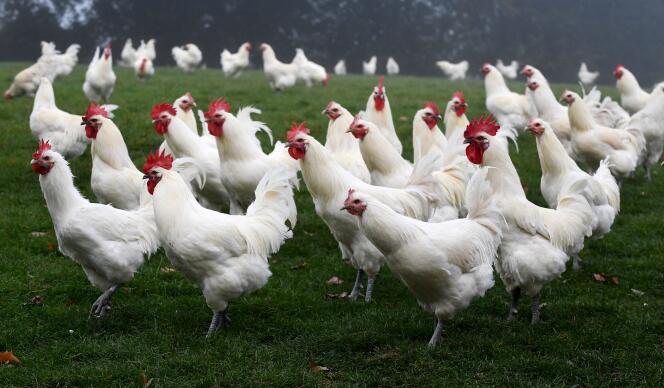In the gymnasium of Montrevel-en-Bresse, in Ain, from 5 a.m., Tuesday December 12, breeders crowd around large tables covered in white. They unravel hens, capons, chickens and turkeys, removing the hand-sewn white sheath that molds their fatty flesh. Then with ribbons between their fingers, blue for the capons, pink for the chickens, they put the final touches to their preparations. The tension is palpable for this kick-off of the 64e edition of the Glorieuses de Bresse, which sees the top of the French poultry farming basket, the famous Bresse poultry, compete every mid-December. Holder of the precious AOC label (appellation d’origine contrôlée), it is a star of festive end-of-year tables.
A final vacuum cleaner to remove the scattered feathers and the farmers slip behind a heavy curtain to share a well-deserved breakfast. The jury can then enter. Chefs, led by Georges Blanc, a star of Ain’s star cuisine, gastronomes and poultry experts look at the competition animals, examining them from head to rump.
How to describe them? “It’s an oblong lump of butter shaped like a rugby ball.”, responds with a joke Max Cormarèche, breeder in Curtafond in Ain. A champion of all categories of these competitions, since he is proud to have lined up at home, twelve vases of Sèvres, the most prestigious of the Glorieuses awards, which take place successively in Montrevel-en-Bresse, Bourg-en-Bresse, Louhans and Pont-de-Vaux. This distinction honors the most homogeneous batch of four capons. A challenge, given the pedigree of these poultry.
“Gray-blue legs, red crest, white feathers”
“The breed of our chickens is the white Gauloise de Bresse, with its grey-blue legs, its red crest and its white feathers. It is a hardy strain that has not been genetically modified. We are not looking for uniformity. When I have a batch of seven hundred animals, at the end of the cycle, I sell them in three to five installments to take into account their respective sizes”, testifies Gaëlle Dimberton, installed since 2022 in the Sougey farm, a showcase establishment owned by the Ain department. With a smile on her lips, this mother of two children recounts her choice to take the plunge, upon reaching forty, leaving her job as a specialized educator to become a farmer.
Mme Dimberton is therefore competing for the first time in the “Espoirs de Bresse” category. A banner that highlights new breeders. Like Valérie Blanc, 25 years old, based in Saint-Nizier-Le-Bouchoux since 2022, or Hélène Jacquet, 30 years old, whose farm is located in Chaveyriat. These examples do not prove that succession is assured. Far from there. Mme Jacquet, was thus the only one to settle in 2021. As for Mr. Cormarèche’s operation, typically Bresse, combining breeding of exceptional Bresse poultry, breeding of Charolais cattle and production of cereals, it comes to be sold to an industrialist from Saint-Etienne wishing to transform it into a horse breeding farm.
You have 55% of this article left to read. The rest is reserved for subscribers.
